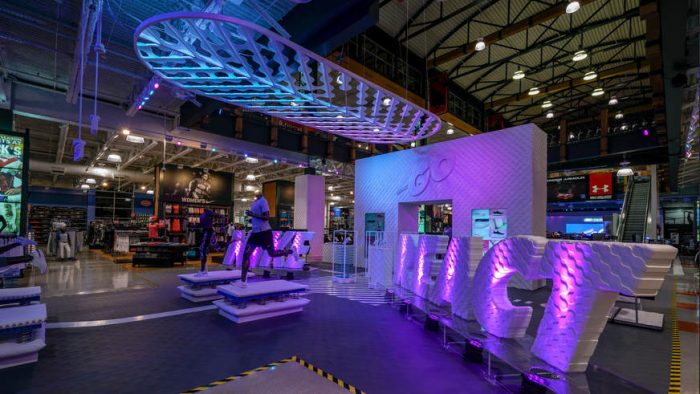Today’s connected consumer expects something more. Highly personalized sharable pop-up events, brand collaborations, and tech-powered interactions have become the new reality of retail. These engaging touchpoints ultimately create brand advocates who are eager to share their experiences.
Despite this change in customer demand and the adoption of new strategies elsewhere in brick-and-mortar, many brands and retailers continue to leverage the same standardized rinse-and-repeat point-of-purchase (POP) displays that have lived in stores for decades. Driven by a focus on sales and profitability, these brands find it challenging to carve out the necessary resources and mind share to change the conversation about creating compelling in-store experiences.
But POP doesn’t have to be a relic of the past. It still holds an important space in today’s retail environment. POP isn’t about eliminating signage altogether; it’s about ensuring that what is produced and placed in the store has a thoughtful and intentional purpose, and forges an emotional connection with the customer.
Breakthrough brands and retailers are reimagining their POP marketing strategies with a renewed focus on creating purposeful, inspiring consumer communications. They’re reallocating traditional budgets to impact key moments in relevant markets that create social engagement and generate macro lift. The focus is on brand affinity and inspiring consumers in the right moments, rather than repeating old strategies for cost savings.
The problem with executing conventional POP for the sake of saving money is that traditional mentality will cost your brand long term in missed connections and therefore missed sales. Today’s consumer expects more from their in-store experience, just as they’ve raised their expectations of the brands’ they support across all marketing platforms.
Nike’s Full-Store Takeover at Dick’s Sporting Goods
Consider the launch of the Nike Epic React shoe at Dick’s Sporting Goods. The brand threw out the traditional playbook and concentrated spend for maximum impact in a full-store takeover—inside and out—of one of the retailer’s flagship locations in the Chicago suburbs. From impactful exterior signage to wayfinding on the floor, customers were led through a powerful immersive brand experience unlike anything seen before in this channel. In fact, Dick’s had never before let a brand takeover its space in its entirety.

Nike emphasized React’s soft, springy, light and long-lasting qualities in an elevated experience from wall to wall. Unique storytelling components for the installation included a mix of tactile elements in a field of pillows and a self-propelled treadmill as well as hundreds of digital screens with event-specific content.
Succeeding in this new consumer environment requires a deep understanding of how the customer is interacting with brand and products. For example, most consumers today research items before filling their cart or making a purchase. They already know what they’re looking for, so they need navigation and direction to find what they’re there to buy.
In-store signage has traditionally messaged speeds and feeds and feature communication, but to create an incredible in-store experience, brands must provide value-driven communication with snackable benefits on how the brand or item will impact a customer’s lifestyle. They must create layers of storytelling that tie into their broader marketing strategies and invest in new and different moments.
Integrating POP into Customer Journeys at Nordstrom
Nordstrom, for example, has highlighted a service-based model with its Nordstrom Local pop-up locations. These shops are dedicated to serving the customer in a way that complements and builds off the service-forward in-store experience they might expect at an established Nordstrom location, from sizing and alterations to manicures and pedicures.
Customers begin their shopping experience online and visit a Nordstrom Local to pick up their orders, or they visit the pop-up to try on outfits curated specifically for them through Nordstrom’s Style Board. The pop-up offers an extension of both digital and in-store experiences. It offers a personal journey that makes customers feel special—and one that they want to share with their friends.
Making POP Matter, Again
Create more of what matters. Lead with communications and in-store experiences that are thoughtful, relevant and differentiated. These are the moments that brand advocates want to talk about:
1) Audit: Reset traditional thinking and processes.
Start by evaluating the legacy and seemingly mandatory signage and communications vehicles in the marketplace. Audit the elements in your environments. Where are they? How are they being leveraged? How are they being activated? Challenge the role of these elements and technologies to ensure that everything is purposeful and ladders up to a thoughtful consumer journey. Narrow down to the must-haves that deliver on this vision and to the business.
2) Edit: Sharing is currency.
Delivering on the new expectation for impactful personal experiences will create emotional connections with consumers and give them something to talk about. As you edit, shift your focus from spending less to spending better. Consider investing in key markets, as Nike did with its React launch, rather than spreading POP spend uniformly across the channel.
3) Inform: What does the consumer want to know? When do they want to know it?
Focus on inspiring through the new and different. What are their friends telling them about your brand or products? Pay particular attention to amplifying the in-store communication moments that have impact and inspire, rather than repeating product specifications that are already at customers’ fingertips on their mobile devices.
Let’s make POP matter again. If you give consumers a thoughtful, informative and impactful experience, they will continue to choose your brand and retailer as a destination. Focus on providing an incredible experience and the transactions will follow.




Point-of-purchase displays definitely still have value today. Studies have shown that 32% of shoppers don’t make lists, and 82% prefer to make purchasing decisions in stores (source: https://www.creativedisplaysnow.com/guides/the-ultimate-beginners-guide-to-pop-displays/why-choose-a-pop-display/). This creates a lot of opportunity for good marketing to influence those decisions. A POP display will make one product stand out from the rest.